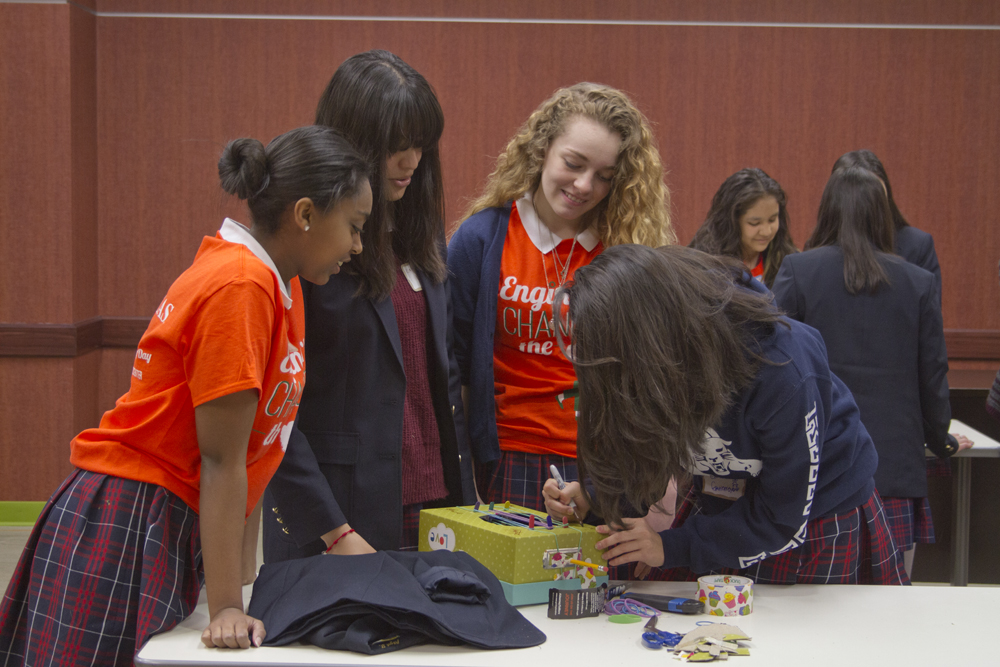Students, faculty explain need for participation from girls in computer science, engineering industries, present role models during event
Women still lag in science, technology, engineering and math jobs as compared to biology, nursing or teaching which have a balanced gender representation in the workforce.
Only 18.2 percent of degrees in computer science and 19 percent of those in engineering and physics are awarded to women, according to the National Girls Collaborative Project.
Boys at the K-12 level are four times more likely to take the advanced placement computer science A exam and two to three times more likely to take an AP physics class, according to the National Science Foundation’s 2014 Science and Engineering indicators.
“The whole divergence between women choosing a STEM field or choosing not to go happens at a really young age because of gender roles,” said Nusha Laleh, mechanical engineering senior and student adviser to the Society of Women Engineers.
Laleh said she believes society imposes gender roles on children such as what colors to wear, how to dress and what is attractive in each gender.
A young girl grows up to believe that to make an impact, she has to join a nonprofit or be a teacher, while still being attractive, whereas engineering jobs often involve wearing overalls and eye protectors and getting their hands dirty — an image girls are conditioned to think of as unattractive, Laleh said.
While almost half of the girls in the eighth grade want to go into a STEM field, by the time they graduate and come to college, very few remain, she said.
This phenomenon is common, especially when comparing the number of elementary school girls who show up to coding camps to the number of high school girls who come to these workshops, said Jey Veerasamy, a senior lecturer in computer science that organizes coding camps and workshops at UTD for school students from elementary through high school around the year.
In a workshop for elementary school kids, there is usually a halfway split between the number of boys and girls, but the number of girls dwindles in the higher grades, he said.
Veerasamy said he noticed that girls are usually afraid of asking questions they think the boys know and will make them look stupid.
Another problem is that girls cannot relate to STEM fields because they don’t see women role models, said Katie Pier, an electrical engineering alumna and an applications engineer at Texas Instruments.
“It’s really important (for me) to encourage girls and women to go into STEM fields and engineering, just to make sure that they get to see some role models,” Pier said. “It can be hard if you look up there and not see (someone) that looks like you.”
Not only is representation in STEM jobs important, it is equally important for girls to see their peers go into these fields, Laleh said. Girls like to have a strong support system around them. Sometimes, they are afraid of venturing into a major where they know they’ll be a minority, she said.
Support from male peers in a classroom is also crucial for a girl to feel like she can succeed, but sometimes, that can be hard to get, said mechanical engineering senior Nancy Dominguez.
Dominguez helped build a device during her internship at the AT&T Foundry which could prevent children from dying in hot cars during summers.
While at UTD, there have been times instances when men in her class have come up to her after she did well on exams assuming she
was awarded more points because she was a girl, Dominguez said.
She said the insunation was that since they had all studied together and just the same amount, she and the other girls who scored more than the men couldn’t possibly have done better otherwise, she said. That attitude upset Dominguez.
“I felt that wasn’t right,” she said. “I thought I did all of my best work, and I think that professors just grade according to your work and not the name they see on top of the page.”
The situation is not too different in the workplace either, despite positive efforts by companies to make STEM jobs appealing to women.
Women make up 47 to 49 percent of the entire workforce in the United States, but when it comes to STEM jobs, they comprise only 24 percent of the working population, according to the Census Bureau’s American Community Survey of 2009.
Texas Instruments runs the TI Women’s Initiative that acts as women’s support group, Pier said.
Dominguez said she encountered two kinds of people at her internship: older men that valued her opinions and older men who were indifferent to her input but were more receptive to her male colleagues.
However, what is perhaps even more prevalent is that women can get very competitive with each other preventing them from having a good support group, she said.
Helping break the stereotype
Every year, since 2009, the Galerstein Women’s Center hosts “Introduce a Girl to Engineering Day” when ninth grade girls from Irma Lerma Rangel Leadership School, a girl-only magnet school in Dallas ISD that ranks tenth in Texas, to come and interact with women leaders in engineering and work on activities that help inform them about the field.
The event helps these girls understand what engineering is all about, said business administration sophomore Maribel Velazquez, an alumna from Irma Rangel herself and a student worker at the Women’s Center.
“It helped me realize whether or not I wanted to go into engineering and whether or not it was something I was interested in,” she said.
Studying with girls helped Velazquez focus on her career and her goals without the distraction of boys or the pressure of stereotypes that her friends from other schools faced, she said.
Luisa Ameola, a ninth grader from the school who attended Girl Day this year, echoed Velazquez’s thoughts. While Ameola is certain she wants to be journalism major, she said studying at Irma Rangel helps her to think her dreams are all reachable.
“(Studying with all girls) makes a difference because I don’t have to impress anybody,” she said. “I’m doing this for me.”
Since fall last year, Veerasamy has helped organize weekly coding workshops that are just for middle school girls. This semester, 10 such workshops have been conducted with 25 students at almost each one.
Usually when the instructor is also a female undergraduate or graduate student from UTD, the attendees are more comfortable asking questions and enjoy the classes more, Veerasamy said.
With time, Veerasamy said hopes that the elementary school and middle school girls attending these workshops will retain their interest in computer science and consider a STEM major.
UTD students are also conducting workshops in people’s homes so that small groups of girls can learn coding along with their friends, so they feel that they fit in with their peers and end up learning more in the process, he said.
Parents, teachers and peers all play an important role projecting the belief in a girl that she can be good at a STEM subject, he said.
Before her internship Dominguez said she had always thought she would have to wait before she got a job and had money to be able to make an impact on the environment and do what she wanted to do, she said.
Yet, she said her internship showed her that small steps can take you to your dream, and engineering can be fun and gratifying at the same time, even if that means sitting in a class of 60 with only nine other girls.














